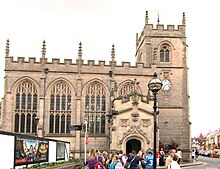Contents


The Guild of the Holy Cross was a medieval religious guild in Stratford-upon-Avon, which was created in 1269, and abolished in 1547. Throughout the period of its existence, the guild was a central institution of Stratford's civic and cultural life, which catered for the town's spiritual needs and fulfilled a range of political and social functions. A number of historical buildings associated with the guild still survive today.[1]
The guild was created in 1269, when Bishop Giffard granted a licence to the brethren to build a chapel and to found a hospital. The Guild Chapel was built soon after. The guild was re-founded in 1403.[2]
The guild attracted members from the local gentry as well as merchants and craftsmen from the town, and concerned itself with the welfare of its members. By the early 15th century the guild had come to own many properties in the town, and it used the rental income from these to provide a number of welfare facilities for its members: In around 1420, it constructed a Guildhall and adjoining Almshouses on Church Street. These buildings became the centre of Stratford's civic life, providing many social and political functions, including housing a grammar school.[1][3]
The guild reached the peak of its influence in the late 15th century, when it had become the town's semi-official governing body, and probably included all of the more important townsmen.[3][2]
In the early 16th century, membership of the Stratford guild declined as a wave of religious change and uncertainty swept across the country during the Tudor period. Finally, the guild was abolished in 1547, under King Edward VI's suppression of religious guilds, with its property confiscated.[3][2]
In response, the inhabitants of Stratford petitioned the Crown for a charter of incorporation as a borough, which they received in 1553. The charter ensured the continuance both of the privileges which the inhabitants had enjoyed, and continuance of the functions which the guild had undertaken, including the payment of the vicar and schoolmaster and the maintenance of the almshouses. Under the terms of the charter, the town's grammar school was re-founded as the King Edward VI School.[3][2]
See also
- Guild of the Holy Cross (Birmingham) - similar institution in nearby Birmingham
References
- ^ a b "4.2 The guild buildings of Shakespeare's Stratford-upon-Avon". Internet Archaeology, University of York. Archived from the original on 26 March 2022. Retrieved 26 March 2022.
- ^ a b c d "The borough of Stratford-upon-Avon: Borough". British History Online. Archived from the original on 18 March 2022. Retrieved 26 March 2022.
- ^ a b c d "2.1 Stratford-upon-Avon and the Guild of the Holy Cross". Internet Archaeology, University of York. Archived from the original on 17 October 2015. Retrieved 26 March 2022.

